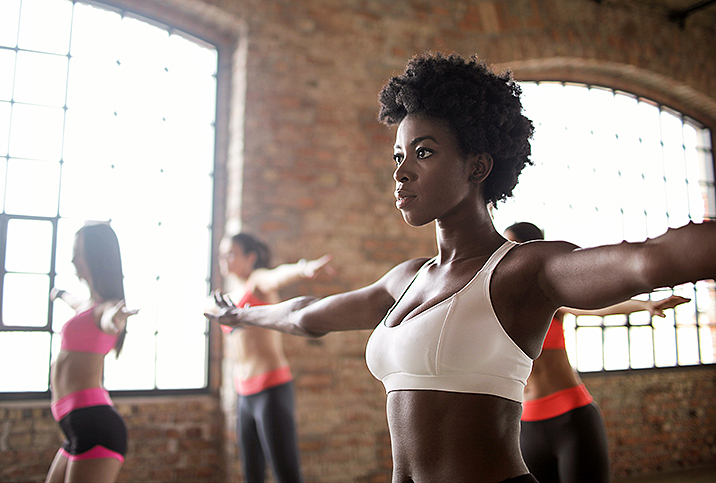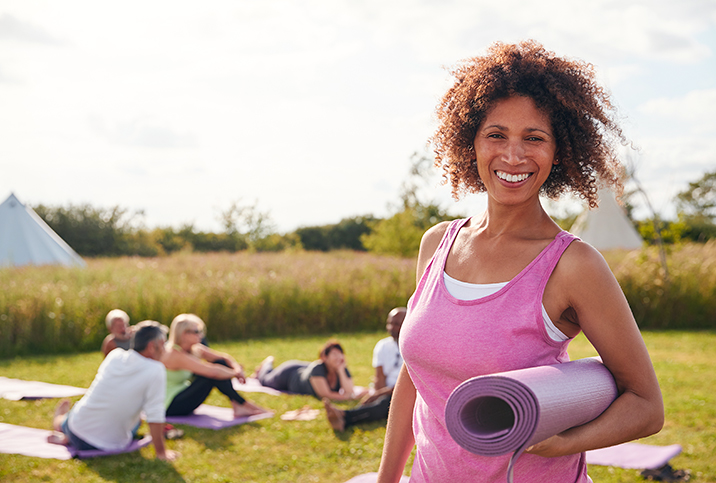The Many Benefits of Exercise for Women

Exercise carries the same health benefits for women and men in many ways, but there are differences between the two in hormones, life stages and the tendency to accumulate body fat.
For this reason, consistent exercise helps reduce a woman's likelihood of chronic diseases such as diabetes and heart disease—which are pretty huge benefits—and can improve fertility, prevent bone loss associated with hormone changes, plus assist with pregnancy and childbirth. It may also reduce the risk of sex-related cancers such as breast and ovarian cancer.
If you've been putting off starting an exercise routine because you're unsure it's worth the effort, here's what you need to know about women's health and exercise.
Women's exercise
The national guidelines for women's exercise are no different from those for men. The Centers for Disease Control and Prevention (CDC) suggests that healthy adults accumulate at least 150 minutes of moderate-intensity exercise each week. This includes activities such as walking, cycling, swimming, dance aerobics and so on.
Additionally, adults should carve out at least two days a week to perform strength-building exercises that target all major muscle groups. Together, these guidelines break down to roughly 30 minutes of exercise per day, five days per week. However, the 30 minutes don't need to be accrued at once. You can break the 30 minutes up into two or three shorter periods of exercise of 10 or 15 minutes.
Additionally, if you opt for higher-intensity exercise (such as running or interval training), or a combination of moderate- and high-intensity exercise, the total amount of time you spend exercising can be decreased, and you can aim for a level between 75 and 150 total minutes per week.
A sample routine might include:
- Monday. 10-minute morning walk, 10-minute walk at lunch, 10-minute evening walk
- Tuesday. 20-minute strength training circuit workout, 10-minute walk
- Wednesday. 30-minute cardio dance class
- Thursday. 20-minute strength training circuit workout, 10-minute walk
- Friday. 30-minute water aerobics class
Keep in mind that routines can and should be personalized for your exercise preferences and goals. You can increase or decrease your time spent exercising and adjust your schedule based on the workouts you're performing.
Regardless of the schedule you elect to follow, working up to the point where you're consistently meeting the CDC's exercise guidelines is important for a woman's health.
"Exercise is beneficial for women in that it helps to maintain healthy adipose [fat] tissue and it reduces the risk of development of type 2 diabetes and obesity," explained Kirk Parsley, M.D., a sleep expert and retired Navy SEAL based in San Diego as well as a medical team member for LegacyExpeditions.net Triple 7 Expedition. "Women, in general, have more fat than men. Fat is an active tissue producing and secreting multiple hormones, which can influence metabolism and appetite regulation. Exercise, especially weight training, helps increase muscle mass and bone density, which can change as women age. Regular exercise with strength training helps to maintain good bone density, while active skeletal muscle helps boost metabolism."
In other words, a consistent exercise regimen can help you maintain and improve body composition by reducing fat stores and increasing skeletal muscle. By managing body composition, you help control the release of hormones that influence your metabolism and appetite, which can further help you manage your weight and body composition. This is especially useful after menopause when changes in estrogen levels can contribute to fat mass accumulation and reductions in skeletal muscle and bone.
It's important to recognize that exercise significantly influences mental health, hormonal health and mood, too.
"These can become compromised at the start of the menstrual cycle and as women enter perimenopause and menopause," said Rosi Reeves, a certified strength and conditioning specialist (CSCS) and personal trainer, and the owner of FittLivin Fitness in Macomb, Michigan.
Regular exercise can help regulate mood and help you manage some of the symptoms associated with common hormonal changes.
Risks and benefits
The good news about starting an exercise program is that if you start it conscientiously and steadily, the health and injury risks are limited, and heavily outweighed by the health-related benefits.
"There are always risks when starting an exercise program, regardless of gender," explained Rathna Nuti, M.D., an orthopedic physician at DFW Sports Medicine in Texas. "Anyone starting an exercise program should start gradually and get familiar with the exercise itself before increasing the frequency of workouts, the time spent working out, the intensity of the program or the type of exercise performed."
There are some specific details that women should keep in mind as they start a new program.
"Women, because of their hip structure, are more prone to knee injuries. However, with a focus on proper alignment and movement, this isn't a big issue," Parsley said.
If you haven't worked out in some time or you're planning to start an exercise program that involves movements you've never tried before (especially dead lifts or lunges or any type of high-intensity jumping or agility exercises), it's best to work with a trainer to ensure you're performing the movements safely.
As long as you're smart about starting a program slowly and gradually working your way up in time and intensity, the benefits of exercise are significant. The CDC noted the following overarching benefits of exercise:
- Better bone, muscle and joint maintenance
- Improved body composition (increasing lean muscle and decreasing body fat)
- Improved mood and well-being
- Improved symptoms of arthritis
- May enhance the effects of estrogen replacement therapy in decreasing bone loss after menopause
- Reduced blood pressure in individuals with hypertension
- Reduced risk of developing colon cancer
- Reduced risk of developing high blood pressure
- Reduced risk of developing type 2 diabetes
- Reduced risk of dying from heart disease
- Reduced symptoms of anxiety and depression
The U.S. Department of Health and Human Services' Office on Women's Health points to some very important benefits for women as they age:
- Improved independence and the ability to perform activities of daily living without assistance
- Reduced risk of falls and resulting broken bones (which, if bone health is compromised by osteoporosis, can be particularly difficult to recover from)
- Reduced risk of muscle and bone loss (which in turn can help prevent falls and fractures)
Regular exercise may reduce the risk of developing breast cancer and cervical cancer, and appears to improve the outcomes of patients diagnosed with ovarian cancer.
When weighing the long-term benefits of regular exercise against the potential risks, the benefits far outweigh the limited downsides. Oh, and those benefits? They extend to sexual and reproductive health as well.
Exercise and sexual health
The facets that contribute to women's sexual health are a bit complicated and nuanced. Mental health, including factors such as stress, anxiety and depression, can play a role in a woman's desire for sex, while physical health plays a role in her engagement with and enjoyment of sex.
"Regular exercise impacts women's sexual health by improving sexual function," Nuti explained. "Exercise increases circulation of blood flow throughout the body and helps ensure a healthy circulatory system. A strong, smooth flow of blood throughout the body is key for arousal and is instrumental in maintaining vaginal lubrication and clitoral sensation."
Another important benefit of exercise, particularly strength exercises, is a stronger pelvic floor. The pelvic floor includes the muscles you engage when you're trying not to urinate. These are also engaged when performing Kegels or strength-training moves that require core engagement.
"Strengthening the pelvic floor will make the act of sex more pleasurable," Reeves said.
A 2021 study published in Investigative and Clinical Urology found women with stronger pelvic floors were more likely to engage in sex and experience orgasm than those with weaker pelvic floors.
But the benefits extend beyond the nuts and bolts of erogenous zone circulation and pelvic floor engagement.
"Regular exercise can boost energy for more 'rev' in the bedroom," Parsley said. "Body confidence naturally improves with a regular exercise routine, independent of body size."
These two factors together—more confidence and more energy—can end up leading to a more active and enjoyable sex life.
"With increased strength and endurance, women's sexual stamina will increase, allowing for more, and longer, fun between the sheets," Reeves said.
Not to ignore the impact of a woman's stress levels and mental health on sexual desire, it's also important to note a regular exercise routine can help reduce stress and symptoms of mild to moderate anxiety and depression. These improvements in mental health may, in turn, improve a woman's desire for sex.
Exercise and reproductive health
The importance of exercise for women's reproductive health shouldn't be ignored. First, recognize that reproductive health refers to fertility at the point of trying to conceive and pregnancy itself, and the lifelong hormonal and physical phases women go through as a byproduct of having the ability to bear children.
These changes include the onset of an adolescent's periods and the hormonal phases their body goes through each month to support menstruation. Reproductive health also includes fertility, pregnancy, childbirth, postnatal recovery, lactation, the return to prebirth fertility and, eventually, perimenopause and menopause.
Maintaining a regular and consistent exercise program can help support and improve each phase of a woman's reproductive health.
"Exercise can help alleviate menstrual cycle symptoms such as bloating, cramps and overall discomfort," Parsley said. "With respect to pregnancy, research has shown that women who exercise while pregnant have a decreased risk of gestational diabetes. Further, the baby benefits in utero as well as postpartum. Multiple studies have shown that babies born to women who regularly exercise are healthier and more intelligent than those born to sedentary women."
Nuti agreed with Parsley and added that exercise can help safeguard a woman's fertility.
"Vigorous exercise reduces the risk of ovulation problems, while moderate exercise decreases the risk of miscarriage and increases the chance of having a baby among women who are undergoing assisted reproductive fertility treatments," Nuti said.
It is possible to take a good thing too far. Extreme exercise routines—typically those that last for hours each day and are accompanied by very low body fat percentages and high physical stress levels that interfere with hormonal health—can lead to changes in menstrual cycles and suppress ovulation. For women looking to get pregnant or those who are pregnant and want to start an exercise routine, it's important to talk to your doctor to ensure you're approaching fitness in a healthy and sustainable way that will help support fertility and reproductive health rather than harm it.
Getting started
According to the CDC, about 60 percent of women fail to meet physical activity guidelines, with 25 percent of women failing to engage in any physical activity at all.
Considering all of the potential benefits, including the reduction in risk of chronic diseases and the improvements in mental, physical, sexual and reproductive health, the potential positive outcomes far outweigh the risks. But if committing to 150 minutes of physical activity each week just seems like too much, remember that exercise isn't an "all or nothing" endeavor.
Even five to 10 minutes of exercise per day (including brisk walking) can offer health benefits for people who are currently sedentary. So rather than do nothing, do something.
And get started today.


















